EdgeNebula: The UK startup turning disused office spaces into micro-datacentres

Warnings about power supply issues and the scarcity of suitable sites to build new server farms have led to persistent concerns about how sustainable the UK datacentre market’s growth is, with demand for compute capacity in the London region increasingly outstripping supply.
Real estate consultancy CBRE released figures in August 2024 that confirmed vacancy rates in the Frankfurt, London, Amsterdam, Paris and Dublin (FLAPD) region reached an all-time low by the end of the first six months of the year. Last year also marked the fifth consecutive year that vacancy rates across FLAPD have declined.
As acknowledged in CBRE’s accompanying report, London was the only region during the second quarter of 2024 to have a new supply of datacentre compute capacity come online, in the form of a 30MW facility in West London.
With colocation and hyperscale providers looking to procure as much spare compute capacity as possible to serve the enterprise market’s appetite for public cloud and artificial intelligence (AI) services, many more developments of this ilk will be needed.
The new Labour government has acknowledged this since its election in July 2024 by making moves to lower the planning permission barriers that have stopped new datacentre developments coming online, particularly in London and the South East.
The government’s pre-election manifesto talked up the wider economic benefits of supporting the growth of the UK datacentre market, which gives some indication of the source of its pro-datacentre sentiment.
Since coming to power, decisions made by the previous government to block large-scale datacentre developments from being built on protected green belt land have been overturned to free up large parcels of undeveloped land so that more hyperscale facilities can be built.
Market growth prioritised
In Whitehall’s view, sacrificing large swathes of the country’s protected green spaces is a price worth paying to ensure the UK’s datacentre market continues to grow and prosper.
However, an alternative solution to meeting the growing need for new datacentres is being put forward by UK-based startup EdgeNebula, which involves converting existing pockets of disused commercial property and office spaces into micro-datacentres.
These edge-like sites will be connected together to form an “amorphous” mass of compute capacity that can be collectively used to host cloud and AI workloads, according to EdgeNebula CEO Peter Hannaford. “We’re not looking to convert the [whole] building into a datacentre,” he tells Computer Weekly. “What we’re looking to do is distribute cloud and AI [workloads] using redundant real estate and power.”
Data from IT market watcher Synergy Research Group, published in January 2025, suggests the average size of a hyperscale datacentre is on the rise, as a direct result of the growing demand for generative AI (GenAI) workloads.
So much so, Synergy is predicting that hyperscale datacentres will double in size over the next four years, which is not great news for operators already struggling to find sites in the UK large enough to accommodate hyperscale datacentre campus developments.
In Hannaford’s view, the concept EdgeNebula is proposing is the answer to this problem, as it will enable operators to access the datacentre compute capacity they need in a much more eco-friendly way.
This is because its datacentres will be housed in pre-existing sites, meaning the environmental cost involved in creating them is substantially lower than building a hyperscale facility from scratch.
On this point, Microsoft went public in October 2023 about the work it’s doing to reduce the amount concrete used to build its hyperscale datacentres as part of a wider body of work to become a “carbon-negative” entity by 2030.
“The buildings already exist, so we won’t need to use concrete and generate huge amounts of carbon emissions to create our datacentres,” says Hannaford. “We’ll also be [linking our sites] up to district heating networks, and making the heat generated from our operations commercially available.”
The types of sites EdgeNebula is targeting will already be connected to local electricity grids, which will accelerate the time it takes to repurpose an office space into a datacentre, he said.
“Some operators are having to wait years to get regulatory approval for power supplies,” says Hannaford, when there are “pockets” of “stranded power” attached to the disused commercial properties ready and waiting to be tapped into.
While the government has committed to lowering the planning permission barriers to building datacentres in the UK, securing approval for projects can still take months. “By repurposing underutilised urban real estate and stranded power, our AI-ready datacentres scale in weeks, reducing costs, minimising strain on the grid and avoiding disruption to natural landscapes,” he adds.
“The other thing about what we’re doing is that you don’t need planning permission to put a few racks in [an existing site].”
Industry experience
Industry veteran Hannaford launched EdgeNebula in November 2024, having previously chaired sector-specific recruitment firm Datacenter People until April 2020. While working there, he founded datacentre-focused executive search and strategy consultancy Portman Partners in 2018.
“That work involved finding the right people to work for the big datacentre operators, and we know how difficult that can be, but we also know the pressures operators face when trying to find the right location for their datacentres, too,” he continues.
As well as power and space, EdgeNebula will also take care of the cooling and connectivity requirements of its sites, but the responsibility for kitting them out will be on Abu Dhabi-based Maerifa Solutions.
The two firms signed a strategic partnership in November 2024 that will see Maerifa supply the high-performance computing (HPC) hardware needed to run cloud and AI workloads in EdgeNebula environments.
Since going public with its concept in November 2024, Hannaford claims to have received positive feedback on its vision from around the world. “We’ve had all sorts of inquiries in from potential investors, to people looking to get rid of their portfolios of empty real estate from all over the world, but [wholesale site conversions] are not what we’re looking to do,” he reiterates.
With analysts forecasting that hyperscale datacentres will need to get even bigger in size to accommodate the demand for public cloud and GenAI workloads, Hannaford is of the view that now is the time for the industry to rethink its approach to delivering these power-hungry workloads.
This is particularly true in light of the UK government’s recently announced AI opportunities action plan, which advocates creating designated zones where AI-ready datacentres will be built to meet this demand. “The government’s AI blueprint is an exciting step forward and the mission is to be applauded,” he says. “However, how we provide the datacentre capacity to achieve this goal is important.”
Unnecessary projects
Referencing the overturning of Buckingham Council’s decision to block a US-based company from building a 65,000m2 hyperscale datacentre in Iver, Buckinghamshire, by secretary of state Angela Rayner, Hannaford says this type of project “simply is not necessary”.
“There is currently over 30 million square feet of office space vacant in the UK today, and a similar amount of unused industrial space,” he says. “We’ve also identified at least 1,000 sites with the power required for a network of smaller datacentres.
“Designed for sustainable AI growth, our approach aligns with the government’s priorities while addressing the challenges of high startup costs and lengthy timelines associated with traditional hyperscale datacentres,” says Hannaford.
It’s certainly a compelling proposition for a market that needs to urgently find new spaces to grow into, so – for now – it’s simply a case of watching and waiting to see if the industry takes him up on his offer.




